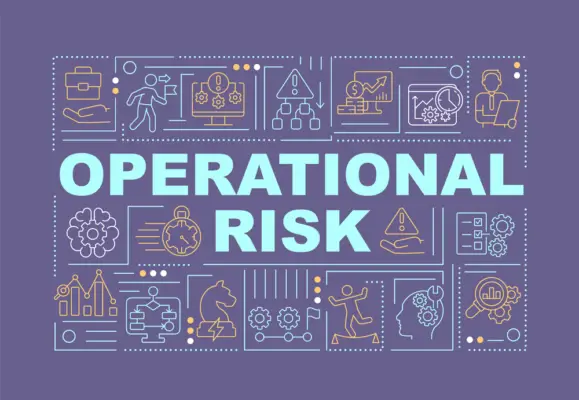Operational risk assessment plays a fundamental role in managing risks effectively within organizations. It’s a meticulous process that involves identifying, analyzing, evaluating, and prioritizing operational risks to establish appropriate mitigation measures and controls.
According to a report by the Institute of Operational Risk, these assessments help organizations maintain a robust operational risk management framework.
This article aims to provide a comprehensive understanding of the definition of operational risk assessment.
Operational risk refers to the potential for losses resulting from inadequate or failed internal processes, people, and systems or from external events, as defined by the Basel II accord.
Operational risk assessment is the systematic evaluation of these potential risks within an organization’s operations. This involves examining various factors such as process vulnerabilities, human errors, technology failures, legal and regulatory compliance issues, and external threats.
The process of operational risk assessment begins with identifying and documenting potential risks associated with specific operations or activities. This is followed by analyzing the likelihood and impact of each identified risk event on the organization’s objectives, a process endorsed by the International Organization for Standardization (ISO 31000).
The next step involves evaluating and prioritizing these risks based on their severity and potential consequences.
Once the risks are assessed and prioritized, appropriate mitigation measures are implemented to reduce their likelihood or impact.
These measures can include implementing robust internal controls, enhancing employee training programs, improving technological infrastructure, or transferring certain risks through insurance coverage.
In today’s dynamic business environment where organizations face ever-evolving challenges and uncertainties, operational risk assessment becomes even more significant.
By proactively identifying and managing operational risks effectively, organizations can enhance their resilience against unexpected events while safeguarding their reputation, financial stability, and overall performance.
In the following sections, this article will delve into each aspect of operational risk assessment in detail to provide readers with a thorough understanding of its importance in contemporary business practices.

Importance of Operational Risk Assessment in Risk Management
The importance of operational risk assessment in risk management lies in its ability to identify and evaluate potential risks that could adversely impact an organization’s day-to-day operations, thereby enabling proactive measures to be implemented for the mitigation and prevention of such risks.
In today’s technologically advanced world, the role of technology in operational risk assessment cannot be overstated. With the increasing complexity of business processes and operations, organizations rely heavily on technology to identify and assess risks more efficiently and effectively.
Technology enables automation of data collection, analysis, and reporting, allowing for real-time monitoring and identification of potential risks.
Additionally, best practices in operational risk assessment emphasize a holistic approach that considers both internal and external factors while evaluating risks. This includes assessing the effectiveness of existing control measures.
Conducting scenario analyses to identify vulnerabilities, regularly reviewing risk appetite frameworks, and fostering a strong risk culture within the organization. This approach is in line with the recommendations of the Committee of Sponsoring Organizations of the Treadway Commission (COSO).
By adopting these best practices and leveraging technology effectively, organizations can enhance their operational risk assessment capabilities significantly.
Process of Identifying and Analyzing Operational Risks
In the process of identifying and analyzing operational risks, an organization conducts a thorough examination of potential threats and vulnerabilities to its internal processes and systems.
This step is crucial in risk management as it allows businesses to proactively identify areas of weakness and implement appropriate controls to mitigate potential losses or disruptions.
To effectively identify operational risks, organizations typically follow a systematic approach that involves:
- Risk identification: This entails conducting a comprehensive review of all internal processes, systems, and activities to identify potential sources of risk. This can include conducting interviews with key stakeholders, reviewing historical data, and utilizing risk assessment tools.
- Risk assessment: Once risks have been identified, they are assessed based on their likelihood of occurrence and the potential impact on the organization. This involves quantifying risks using various metrics such as probability, severity, and frequency.
- Risk prioritization: After assessing the identified risks, organizations prioritize them based on their significance. Risks with higher severity or likelihood are given more attention in terms of resource allocation for mitigation efforts.
Following this process of identifying risks and conducting risk analysis, organizations can effectively manage operational risks and enhance their overall resilience against potential disruptions.
Evaluation and Prioritization of Operational Risks
Effective management of operational risks involves evaluating and prioritizing potential threats and vulnerabilities within an organization’s internal processes and systems.
Risk evaluation is the process of assessing the likelihood and impact of identified risks, considering factors such as frequency, severity, and detectability. This evaluation provides a comprehensive understanding of the potential consequences associated with each risk.
Once risks have been evaluated, they can be prioritized based on their significance to the organization’s objectives and overall risk appetite. Risk prioritization ensures that resources are allocated effectively to address the most critical risks first.
It involves ranking risks based on their potential impact, likelihood of occurrence, and other relevant criteria.
Systematically evaluating and prioritizing operational risks, organizations can proactively manage them in a targeted manner, reducing potential losses and maximizing opportunities for improvement.
| Criteria | Weighting |
|---|---|
| Impact | High |
| Likelihood | Medium |
| Detectability | Low |
Incorporating a table like this allows for a visual representation of how different criteria are weighted when evaluating operational risks.
Assigning weights to each criterion according to their relative importance, organizations can objectively prioritize their response efforts based on these assessments.

Implementing Mitigation Measures and Controls
To successfully manage potential threats and vulnerabilities within an organization’s internal processes and systems, the implementation of targeted mitigation measures and controls is crucial.
Implementing risk mitigation and control measures involves identifying specific actions to reduce the likelihood or impact of operational risks.
These measures can include implementing robust internal controls, such as segregation of duties, regular monitoring, and reporting mechanisms, as suggested by the Federal Financial Institutions Examination Council (FFIEC).
Additionally, organizations may need to establish contingency plans to address potential disruptions or failures in their operations.
The effectiveness of these measures relies on a thorough understanding of the identified risks and their potential consequences.
It is important to regularly review and update these measures to adapt to changing circumstances and emerging risks.
By implementing comprehensive mitigation strategies, organizations can proactively manage operational risks, enhance resilience, and protect their reputation and financial stability.
Significance of Operational Risk Assessment in Today’s Business Environment
Operational risk assessment plays a crucial role in today’s dynamic business environment by providing organizations with valuable insights into potential vulnerabilities and threats that could impact their operations and reputation.
This process not only helps organizations identify and assess potential risks but also enables them to implement robust mitigation measures and controls.
The role of technology in operational risk assessment cannot be overstated, as it allows for the automation of data collection, analysis, and reporting, thereby enhancing the efficiency and accuracy of the assessment process.
Furthermore, operational risk assessment has a direct impact on organizational performance by enabling proactive risk management, reducing costly incidents and disruptions, improving decision-making processes, and enhancing stakeholder confidence.
Overall, operational risk assessment is an essential tool for organizations seeking to navigate the complexities of today’s business landscape effectively.
Frequently Asked Questions
What are the common challenges faced by organizations when conducting operational risk assessments?
Common challenges faced by organizations when conducting operational risk assessments include identifying all potential risks, gathering accurate and comprehensive data, ensuring consistency in assessment methodologies, and incorporating best practices to mitigate identified risks effectively.
How does operational risk assessment contribute to the overall risk management strategy of an organization?
Operational risk assessment contributes to an organization’s overall
risk management strategy by providing valuable information for decision-making. It identifies potential risks, assesses their impact on financial performance, and helps prioritize mitigation efforts for effective risk management.
Are there any regulatory requirements or industry standards that organizations should follow when conducting operational risk assessments?
Yes, organizations should adhere to regulatory compliance and industry best practices when conducting operational risk assessments. These requirements ensure that organizations meet legal obligations and follow recognized standards for assessing and managing operational risks.
For instance, financial institutions are regulated by guidelines such as the Basel III standards and the Dodd-Frank Act, which require rigorous operational risk assessments.
Can you provide examples of real-life scenarios where operational risk assessments have helped organizations mitigate potential risks?
Absolutely. One notable example is the 2008 financial crisis, where the lack of adequate operational risk assessment contributed to the collapse of several major financial institutions.
Post-crisis, these institutions have implemented robust operational risk assessment procedures to identify, manage, and mitigate risks effectively. Regular assessments, involving key stakeholders, and integrating assessment findings into decision-making processes are now integral parts of their risk management strategies.
How frequently should organizations review and update their operational risk assessments to ensure they remain effective and relevant?
Organizations should regularly review and update their operational risk assessments to ensure they remain effective and relevant. The frequency of updates depends on the organization’s specific needs, but typically ranges from annually to every few years. In fact, some standards, like ISO 31000, recommend continuous monitoring and periodic review of the risk management process.

Conclusion
Operational risk assessment plays a pivotal role in effective risk management.
By identifying and analyzing operational risks, businesses can better understand potential threats and their potential impact on operations.
Through evaluation and prioritization, organizations can allocate resources effectively to mitigate the most significant risks.
Implementing mitigation measures and controls further enhances the ability to manage operational risks successfully.
In today’s complex business environment, an in-depth understanding of operational risks is essential for ensuring the overall stability and resilience of an organization.
Operational risk assessment, when properly conducted and regularly updated, can provide organizations with the necessary tools to navigate through the uncertainties and complexities of the current business landscape.
This process, backed by a solid understanding of the organization’s operations and potential risks, can contribute significantly to the long-term success and sustainability of an organization.

Chris Ekai is a Risk Management expert with over 10 years of experience in the field. He has a Master’s(MSc) degree in Risk Management from University of Portsmouth and is a CPA and Finance professional. He currently works as a Content Manager at Risk Publishing, writing about Enterprise Risk Management, Business Continuity Management and Project Management.

